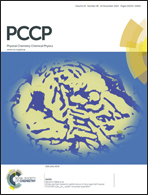The model case of an oxygen storage catalyst – non-stoichiometry, point defects and electrical conductivity of single crystalline CeO2–ZrO2–Y2O3 solid solutions
Abstract
The ternary solid solution CeO2–ZrO2 is known for its superior performance as an oxygen storage catalyst in exhaust gas catalysis (e.g. TWC), although the defect chemical background of these outstanding properties is not fully understood quantitatively. Here, a comprehensive experimental study is reported regarding defects and defect-related transport properties of cubic stabilized single crystalline (CexZr1−x)0.8Y0.2O1.9−δ (0 ≤ x ≤ 1) solid solutions as a model system for CeO2–ZrO2. The constant fraction of yttria was chosen in order to fix a defined concentration of oxygen vacancies and to stabilize the cubic fluorite-type lattice for all Ce/Zr ratios. Measurements of the total electrical conductivity, the partial electronic conductivity, the ionic transference number and the non-stoichiometry (oxygen deficiency, oxygen storage capacity) were performed in the oxygen partial pressure range −25 < lg pO2/bar < 0 and for temperatures between 500 °C and 750 °C. The total conductivity at low pO2 is dominated by electronic transport. A strong deviation from the widely accepted ideal solution based point defect model was observed. An extended point defect model was developed using defect activities rather than concentrations in order to describe the point defect reactions in CeO2–ZrO2–Y2O3 properly. It served to obtain good quantitative agreement with the measured data. By a combination of values for non-stoichiometries and for electronic conductivities, the electron mobility could be calculated as a function of pO2, ranging between 10−2 cm2 V−1 s−1 and 10−5 cm2 V−1 s−1. Finally, the origin of the high oxygen storage capacity and superior catalytic promotion performance at a specific ratio of n(Ce)/n(Zr) ≈ 1 was attributed to two main factors: (1) a strongly enhanced electronic conductivity in the high and medium pO2 range qualifies the material to be a good mixed conductor, which is essential for a fast oxygen exchange and (2) the equilibrium constant for the reduction exhibits a maximum, which means that the reduction is thermodynamically most favoured just at this composition.


 Please wait while we load your content...
Please wait while we load your content...